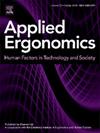Developing and validating a Chinese human-automation trust scale: Advancing trust measurement of emerging automation in sustainable ergonomics
IF 3.4
2区 工程技术
Q2 ENGINEERING, INDUSTRIAL
引用次数: 0
Abstract
Measuring humans’ learned trust in emerging automation systems across different trust development stages is important for fostering a sustainable and human-centered human-automation interaction. Given the notable differences in human-automation trust between Chinese culture and other cultures, particularly Western cultures, the development of an effective measurement tool for human-automation trust within Chinese cultural context is indispensable. This study aimed to develop a Chinese version of the Human-Automation Trust Scale (C-HATS) with reasonable reliability and validity, based on several existing theories and scales related to human-automation trust. Following three phases of assessments, including exploratory factor analysis, item analysis, and confirmatory factor analysis, the scale demonstrated reasonable reliability and validity for both initial and post-task trust assessments. However, certain items of our C-HATS should be separately applied when assessing initial and post-task trust. Furthermore, it is crucial to acknowledge the structural differences between initial and post-task trust. Post-task trust consists of three factors: performance, process, and purpose-based trust, whereas initial trust consists of only two dimensions: cognition-based and affect-based trust. These distinctions should be considered when evaluating the subfacets of initial and post-task trust. Although further validation is required, the developed C-HATS has the potential to assess initial and post-task human-automation trust within Chinese cultural context across various automation systems.
中国人-自动化信任量表的开发与验证:推进可持续工效学中新兴自动化的信任测量
衡量新兴自动化系统中不同信任发展阶段的人类习得信任对于促进可持续的、以人为中心的人机交互非常重要。鉴于中国文化与其他文化,特别是西方文化在人-自动化信任方面的显著差异,在中国文化背景下开发一种有效的人-自动化信任测量工具是必不可少的。本研究旨在基于现有的几种与人-自动化信任相关的理论和量表,编制具有合理信度和效度的中国版人-自动化信任量表(C-HATS)。经过探索性因子分析、项目分析和验证性因子分析三个阶段的评估,该量表在任务初始和任务后的信任评估中均表现出合理的信度和效度。然而,在评估初始和任务后信任时,我们的C-HATS的某些项目应分别应用。此外,认识到初始和任务后信任之间的结构差异是至关重要的。任务后信任包括绩效信任、过程信任和目的信任三个维度,而初始信任仅包括认知信任和情感信任两个维度。在评估初始和任务后信任的子方面时,应该考虑这些区别。虽然需要进一步验证,但开发的C-HATS具有在中国文化背景下评估各种自动化系统中初始和任务后人类自动化信任的潜力。
本文章由计算机程序翻译,如有差异,请以英文原文为准。
求助全文
约1分钟内获得全文
求助全文
来源期刊

Applied Ergonomics
工程技术-工程:工业
CiteScore
7.50
自引率
9.40%
发文量
248
审稿时长
53 days
期刊介绍:
Applied Ergonomics is aimed at ergonomists and all those interested in applying ergonomics/human factors in the design, planning and management of technical and social systems at work or leisure. Readership is truly international with subscribers in over 50 countries. Professionals for whom Applied Ergonomics is of interest include: ergonomists, designers, industrial engineers, health and safety specialists, systems engineers, design engineers, organizational psychologists, occupational health specialists and human-computer interaction specialists.
 求助内容:
求助内容: 应助结果提醒方式:
应助结果提醒方式:


